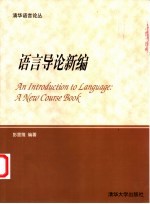

语言导论新编PDF电子书下载
- 电子书积分:12 积分如何计算积分?
- 作 者:彭宣维编著
- 出 版 社:北京:清华大学出版社
- 出版年份:2003
- ISBN:7302061904
- 页数:312 页
Part One A Setup for Language 3
Chapter 1 Language as a Set of Facts 3
1.1 Language as a Set of Facts 4
1.1.1 Language as a socio-historical fact 4
1.1.2 Language as a neurological as well as cognitive fact 9
1.2 Language as a Fact of Its Own:the Design Features 12
1.3 Language as Entity vs.Speaking/Writing as Substance 19
Chapter 2 Language as Text 26
2.1 Language as Process 26
2.1.1 The naming process 26
2.1.2 Meaning:one level of language 31
2.1.3 Wording/Grammar:another level of language 34
2.2 Language as Text 36
2.2.1 What is a text? 36
2.2.2 Word-text continuum 39
2.3 From Situation to Language 45
Part Two Word:Sense,Lexeme & M.Foot 55
Chapter 3 What is Word?—A Definition 55
3.1 What is Word?A Transverse Perspective 55
3.2 How Is A Word Made Up?A Vertical Perspective 63
3.3 Meaning Types:the Neglected Aspect of Word Classification 69
Chapter 4 Words(1):Senses and Sense Relations 79
4.1 Ideational Words 79
4.1.1 Experiential meanings 80
4.1.2 Logical meanings 85
4.2 Interpersonal Words 90
4.2.1 Modal words 90
4.2.2 Evaluative words 93
4.2.3 Words of formality 97
4.3 Informational Words 100
4.3.1 Words of"Given"value 100
4.3.2 Words of"New"value 107
Chapter 5 Words(2&3):Lexeme and Metrical Foot 110
5.1 Morpheme and Lexeme 110
5.1.1 Morpheme,affix,root and stem 111
5.1.2 The functions of affixes 114
5.1.3 Morpheme vs.meaning 119
5.2 Phoneme,Syllable and Metrical Foot 123
5.2.1 Phonemes 123
5.2.2 Syllable and metrical foot 131
Part Three From Word to Sentence 139
Chapter 6 Word Group and Phrase 139
6.1 Word Group 139
6.1.1 Nominal group 140
6.1.1.1 The formal aspect of nominal group 140
6.1.1.2 The meaning/experiential aspect of nominal group 142
6.1.2 Verbal group:the meaning and wording 146
6.1.3 Adverbial,conjunction and preposition groups 150
6.1.4 The phonological aspect of word group 153
6.2 Prepositional Phrase 156
Chapter 7 Sentence(1):Interpersonal Meaning and Form 161
7.1 Introduction:Clause Complex as Transitional Rank 161
7.2 Mood and Its Form in Clause and Clause Complex 164
7.2.1 In the clause 164
7.2.2 In the clause complex 167
7.3 Evaluative Meaning in Emphatic Constructions 169
7.4 Formality and Its Form in the Clause and Clause Complex 174
Chapter 8 Sentence(2):Ideational Meaning and Form 181
8.1 The Clause 181
8.1.1 Meaning structure:Transitivity 181
8.1.1.1 What does Transitivity mean? 181
8.1.1.2 Material process 183
8.1.1.3 Mental process 185
8.1.1.4 Relational process 187
8.1.1.5 Verbal,behavioural and existential processes 188
8.1.2 The formal/wording aspect of transitivity 189
8.2 The Clause Complex 192
8.2.1 The Logic-semantic relations within the clause complex 193
8.2.1.1 Expansion 193
8.2.1.2 Extension 194
8.2.1.3 Enhancement 195
8.2.2 Logic-grammatical relations:the form 197
Chapter 9 Sentence(3):Informational Meaning and Form 200
9.1 Topic Structure vs.Thematic Structure 201
9.1.1 Topic structure in the clause 201
9.1.2 Topic system in the clause complex 204
9.1.3 Thematic structure in the clause 206
9 1.4 Thematic structure in the clause complex 208
9.2 Information Structure vs.Word Order 211
9.2.1 In the clause 211
9.2.2 In the clause complex 213
9.3 The Sounding Aspects of the Meanings and Wordings 218
Part Four A Visualized Picture for Text and Language 225
Chapter 10 From Clause to Text 225
10.1 From Clause to Text 225
10.2 The Ideational Perspective of Text 227
10.2.1 The Ideational meaning texture 227
10.3 The Interpersonal Perspective of Text 234
10.3.1 Textual mood meaning 234
10.3.2 Textual evaluative meaning 238
10.3.3 Textual formality and stylistic range 241
10.4 The Informational Perspective of Text 246
10.4.1 Topic systems in text 246
10.4.2 Information flow in text 252
Chapter 11 Register,Perspective and Genre 264
11.1 Register 265
11.1.1 Field of discourse 265
11.1.2 Tenor of discourse 269
11.1.2.1 Verbal roles/behaviours 269
11.1.2.2 Affect/Emotion charge 273
11.1.2.3 Power and solidarity 276
11.1.3 Mode 281
11.1.4 A holistic description from the pragmatic angle 286
11.2 Perspective and Genre 287
Index 301
《语言导论新编》内容提要 310
- 《新编历史小丛书 祖逖北伐》何兹全著 2019
- 《新编高中物理竞赛教程习题全解》钟小平主编;钟小平,倪国富,曹海奇编写 2019
- 《物联网导论》张翼英主编 2020
- 《程序逻辑及C语言编程》卢卫中,杨丽芳主编 2019
- 《材料导论》张会主编 2019
- 《化工传递过程导论 第2版》阎建民,刘辉 2020
- 《新编中草药全图鉴 2》林余霖,李葆莉主编 2020
- 《幼儿园课程资源丛书 幼儿园语言教育资源》周兢编 2015
- 《高等院校旅游专业系列教材 旅游企业岗位培训系列教材 新编北京导游英语》杨昆,鄢莉,谭明华 2019
- 《高等学校“十三五”规划教材 C语言程序设计》翟玉峰责任编辑;(中国)李聪,曾志华,江伟 2019
- 《市政工程基础》杨岚编著 2009
- 《家畜百宝 猪、牛、羊、鸡的综合利用》山西省商业厅组织技术处编著 1959
- 《《道德经》200句》崇贤书院编著 2018
- 《高级英语阅读与听说教程》刘秀梅编著 2019
- 《计算机网络与通信基础》谢雨飞,田启川编著 2019
- 《看图自学吉他弹唱教程》陈飞编著 2019
- 《法语词汇认知联想记忆法》刘莲编著 2020
- 《培智学校义务教育实验教科书教师教学用书 生活适应 二年级 上》人民教育出版社,课程教材研究所,特殊教育课程教材研究中心编著 2019
- 《国家社科基金项目申报规范 技巧与案例 第3版 2020》文传浩,夏宇编著 2019
- 《流体力学》张扬军,彭杰,诸葛伟林编著 2019
- 《大学计算机实验指导及习题解答》曹成志,宋长龙 2019
- 《指向核心素养 北京十一学校名师教学设计 英语 七年级 上 配人教版》周志英总主编 2019
- 《大学生心理健康与人生发展》王琳责任编辑;(中国)肖宇 2019
- 《大学英语四级考试全真试题 标准模拟 四级》汪开虎主编 2012
- 《大学英语教学的跨文化交际视角研究与创新发展》许丽云,刘枫,尚利明著 2020
- 《北京生态环境保护》《北京环境保护丛书》编委会编著 2018
- 《复旦大学新闻学院教授学术丛书 新闻实务随想录》刘海贵 2019
- 《大学英语综合教程 1》王佃春,骆敏主编 2015
- 《大学物理简明教程 下 第2版》施卫主编 2020
- 《指向核心素养 北京十一学校名师教学设计 英语 九年级 上 配人教版》周志英总主编 2019
